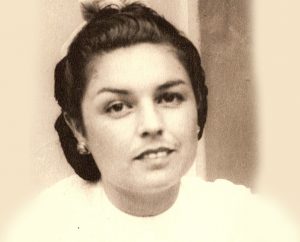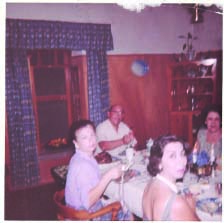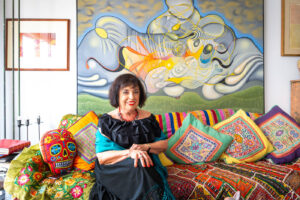My Mother’s Pantry
Glistening by the light of a single bare bulb are jars of canned snails from France, saffron and baby eels from Spain, bamboo shoots and plum sauce from China, and grape leaves in brine from the Middle East. Picture these delicacies in the pantry of a ranch-house in the northern Mexican desert some 40 years ago and some five hours, on bumpy dirt roads, from the nearest store.
It is the summer of 1960. I am 13 and about to embark on an important rite of passage–initiation into my mother’s magical world of cooking. She begins our talk with a discussion about the evening meal to come. (For lunch we had eaten simple Mexican food, but for dinner we will travel the globe, guided by whatever foods my mother happens to have on hand.) My job is to gather everything from the pantry that we will need. I stand there in the tiny room, its air pungent with the brine from father’s cured hams and corned beef, staring in awe at row after row of ingredients from far-away places, neatly arranged by nationality, that mother has picked up on her monthly provisioning trips to El Paso or Tucson. There’s tarragon, chervil, mace, and juniper berries; clams and clam juice; abalone; and galvanized steel trash cans full of pasta. Interspersed with these are the preserves she put up during the summer–tomato sauce, mint jelly, peach halves, and quince paste.
My mother grew up in Sonora at a time when this part of Mexico was isolated from the rest of the country by bad transportation and poor communication. Her grandmother, Mane, taught her to cook homey Sonoran food–tamales con chile colorado (with pork in red chile sauce), albóndigas (meatballs with mint), revolcado (pork-rib stew in red chile, garnished with toasted chile seeds), flour tortillas, and caldillo (beef stew). The only spices available to them were cumin, clove, and canela; the only herb, the oregano that grew wild in the nearby hills. Not until mother was sent off to boarding schools in neighboring states did she come to know the sophisticated mestizo cooking of the south and central Mexican states.
When, during the 1800s, Chinese laborers came to California to help build the railroads, many settled across the border in Mexicali, Baja California, and some opened restaurants. It was at one of these that my teenaged mother first bit into a crunchy egg roll, sampled roast duck fragrant with star anise, and felt the seductive sting of hot mustard. Enraptured, she copied these new tastes and textures in a version of chop suey made with bacon and lots of crisp water chestnuts. When her sister, my tia Panchita, married the oldest son of recent Lebanese emigrants, even more exotic flavors came into her life. Panchita’s in-laws introduced the family to hummus, rice with lentils, shish kebab, tabbouleh, and stuffed grape leaves–dishes that quickly became part of mother’s repertoire too. The Lebanese-inspired meals at our ranch always ended with a demitasse of strong coffee with lots of sugar and a cardamom seed for us to chew–the flavor bursting in our mouths and lasting there for hours.
Mother had met my father when she was in her late teens, and it was his mother, Mariquita, who introduced her to Spanish food. She, in turn, had learned it from her son-in-law, Salvador–a dashing, Daliesque figure who sported a greased, pointed moustache and liked to loll about in a silk smoking jacket. Salvador always traveled with ten trunks and a parrot, and wherever he went he brought an air of excitement and sophistication. It was Salvador who showed my mother how to make sweetbreads in Sherry-cream sauce, callos a la madrileña (Madrid-style honeycomb tripe), and paella.
Mariquita taught her to finish a dish with a little raw garlic (Sonoran cooks used only cooked garlic) and introduced her to bay leaves, which for a whil ebecame her favorite herb. As I wrote down her recipes I would tease her because they all seemed to end with “y una hojita de laurel” (and a little bay leaf). She used bay leaves in her first-ever spaghetti sauce–as she said, her first truly “foreign” dish. Soon she became familiar with fennel seed and would add it to another “foreign” dish, lasagna.
Mother’s true culinary epiphany, though, happened around 1958, at the moment that she tasted Helen Corbitt’s cooking in the dining room at Neiman Marcus in Dallas. She remembers to this day the chicken salad suprème with green grapes and toasted almonds accompanied by an airy molded orange-gelatin salad and served with bite-sized muffins. Immediately she purchased a copy of Helen Corbitt’s Cookbook (published in 1957, it was as trend-setting in its time as The Silver Palate Cookbook would be a generation later) and discovered in its pages a whole new way of preparing and presenting food.
We would try out dishes hitherto unknown to us: Swedish meatballs, hollandaise sauce, cold rice and shrimp salad, roasted lamb with a curried béchamel sauce.
One section of the book was devoted to party menus, which mother faithfully duplicated, inventing a hundred excuses for luncheons, cocktail parties, and fancy dinners. Then, inspired and excited, she took out a subscription to Gourmet and bought the Gourmet Cookbook. Thereafter, food became the primary source of recreation for the entire family. The courtyard of our house was surrounded by the thick stone walls of what had once been a fort built to keep out the Apache Indians. Here, father grew thyme, asparagus, and fraises des bois in the circular stone rueda. Spurred on by his love of Chinese barbecued char sui and smoked meats, he also designed and constructed all sorts of barbecue ovens and smokers. Looking back, what strikes me as remarkable is that it was all done by instinct–there were no thermostats and no means of controlling the temperatures. The rest of the meals would be prepared on a cast-iron stove fed with the wood from local scrub oaks.
As important as food was to my parents, so, too, was the setting. Father insisted the table should always be laid with a tablecloth and crisp cloth napkins. Our Royal Delft china, crystal, and sterling silverware were brought from the pine breakfront he had built in his workshop. There would becandles at night and a centerpiece of plastic flowers (no fresh ones being available). My three sisters and I, plus the assorted cousins and friends who spent summers with us, were expected to taste everything. Mother would explain what we were about to eat and the correct way to eat it, and father usually had some intriguing historical tidbit to contribute. When we grew older, we were allowed to take part in my favorite time of all, the sobremesa–a relaxed after-dinner interlude around the table of conversation and joke-telling that would sometimes stretch into the early morning.
Until the time that their marriages and made it more difficult to get together, most Sunday evenings I sat at the table in my New York City home surrounded by my own children and friends. After we’ve finished the meal that we have lovingly prepared together, we settle into our own small sobremesa. As we talk and reminisce, I rejoice in the knowledge that the legacy that began in my mother’s small, pungently scented pantry in Sonora is being passed on to the next generation. And, I hope, beyond.
This little video is dedicated to my mother from whom I learned many good things and some “bad” ones: My Mother and I am going to try to upload an entire song my mother and I sang together while she played her beloved piano. Cruz de Olvido



